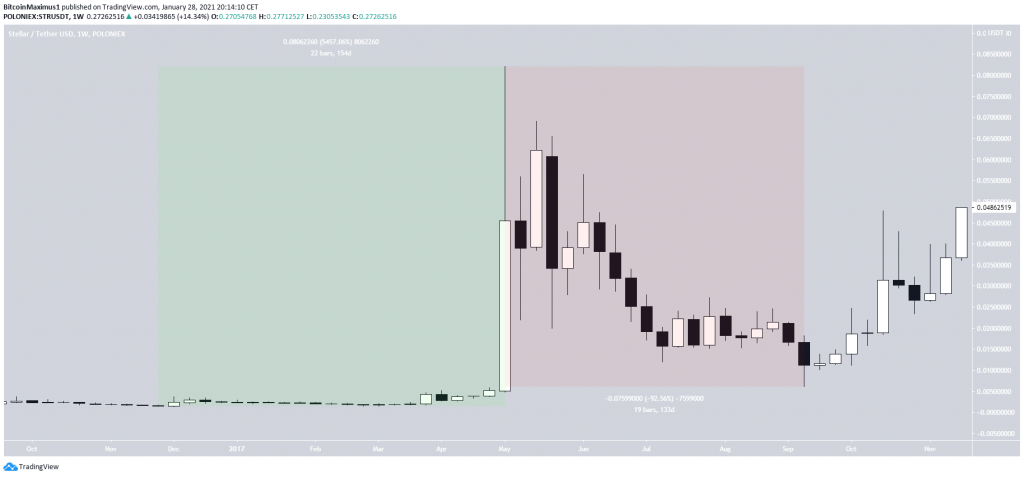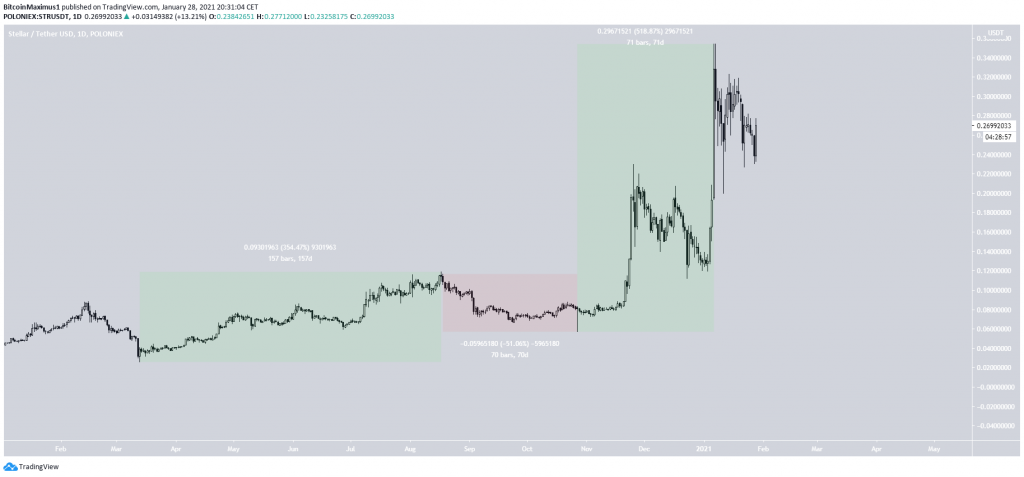There is no denying the fact that Stellar (XLM) belongs to a cohort of the finest cryptocurrencies in terms of their fundamental value, especially in the area of cross-border financial transactions and the issuance of new crypto tokens. Some argue that Stellar is superior to Bitcoin and Ethereum with regard to transaction speed, fees, scalability (which is especially relevant to Ethereum, though the Istanbul hard fork is said to have eased the scalability problem), and the effectiveness of smart contracts.
However, the price of XLM, and any other cryptocurrency, for that matter, don’t depend solely on its fundamentals, or we would have absolutely different top coin rankings. Whereas blockchain and dApp developers may adore Stellar, traders, and especially holders, weren’t going into raptures over XLM’s performance during the previous year. The coin ended the twelve-month run on a negative note and showed nothing but losses on a yearly chart against the USD and the two dominant cryptocurrencies. This resulted in Stellar been pushed from the top 10 by Monero, with Tron stepping on its toes.


To end the quick recap of Stellar’s previous activity, take a look at the 1-year chart which clearly shows that XLM had eagerly participated in the short-term bull run that allowed the coin to reach the 2019 high of $0.141, which is still 84.8% lower than its all-time high of $0.93.


First All-Time High
The first major upward move took place between Nov. 2016 – May 2017. On May 7, 2017, XLM reached an all-time high price near $0.082. The entire upward move lasted 154 days and amounted to an increase of 5,457%.

What followed was a long corrective period, in which it fell by a massive 92% over the next 132 days. The decrease culminated in a low of $0.006 on Sept. 15, 2017. After creating a bullish hammer on the daily time-frame, XLM began an upward move that led to further bullish price action.
Stellar Lumens Price Prediction : XLM Current Movement
The move since the March low can be divided into two cycles. The first one was a gradual increase that played out over 157 days and measured 354%. It was followed by a 50% fall over 70 days, leading to a low of $0.057 in Oct. 2020.
Since then, XLM has been on an accelerated upward path, which resembles the move to the all-time high, increasing 518% in only 71 days. On Jan. 7, it touched a high of $0.41. XLM is currently trading around $0.36.

To summarize, Stellar is likely to continue the consolidation for the next couple of weeks, if it fails to flip the $0.05 resistance into support. However, with no clear signs of a trend reversal, it might be better to monitor XLM without entering long positions.
FAQs
What is the Stellar Lumens price today?
The current price of Stellar Lumens is 0.349 USD today.
Will Stellar Lumens price drop / fall?
Yes. The price of Stellar Lumens may drop from 0.349 USD to 0.344 USD. The change will be -1.362%.
Will Stellar Lumens price grow / rise / go up?
No.
What Is Stellar Lumens Cryptocurrency?
The term Stellar cryptocurrency refers to a digital or virtual currency developed by Stellar Development Foundation. The organization’s currency, which is called the lumen, is traded under the symbol XLM on various cryptocurrency exchanges.1 Lumens can be used by traders on the Stellar network, which is a blockchain-based distributed ledger network that connects banks, payments systems, and people
Understanding Stellar Cryptocurrency
Cryptocurrencies are digital or virtual currencies that were developed for trading on decentralized networks called blockchains. Doing so ensured they couldn’t be counterfeited like regular currencies. It also prevented them from being double-spent. Unlike fiat money, cryptocurrencies aren’t issued by central banks, which means governments don’t interfere in their trading activity. A variety of cryptocurrencies popped up following the success of Bitcoin—created in 2009—including the lumen.
As mentioned above, the lumen is Stellar’s cryptocurrency. There are roughly 22.1 billion coins in circulation, with a maximum supply of 50 billion.3 The Stellar Foundation originally had over 100 billion lumens in existence but burned roughly half of its outstanding coins in November 2019.4 The move caused a short-term rise in the price of XLM, though the rally quickly faded. Coin burns are controversial because they imply the kind of manipulation that decentralized systems are supposed to protect against.
Although the value of Stellar’s lumen dropped by more than two-thirds as of May 2020, it is still one of the best performing altcoins, taking the 11th spot on CoinMarketCap.3 The coin’s market capitalization was $6.086 billion as of Jan. 22, 2021.3
Stellar’s primary focus is on developing economies in the areas of remittances and bank loans to those who are outside of the scope of the banking services. Stellar doesn’t charge individuals or institutions for using the network. Stellar supports a distributed exchange mode. This allows users to send payments in specific currencies even though they may hold credits in another, while the network automatically performs the forex conversion. The receiver can withdraw their currency equivalent through a partner institute like a bank.
Special Considerations
Stellar is operated by the Stellar Development Foundation, a nonprofit organization founded by Jed McCaleb. The Stellar project received initial funding from the payments startup Stripe, along with donations from organizations like BlackRock, Google, and FastForward. The organization covers its operational costs by accepting tax-deductible public donations.67
As a cross-border transfer and payment system that connects financial entities, Stellar aims to significantly reduce transaction costs and time lags. While Stellar works just like technologies like Bitcoin, its key distinguishing feature is its consensus protocol. The present-day Stellar is a result of a 2014 fork that created the Stellar Consensus Protocol (SCP) following which Stellar became an open-source system. Under this protocol, the transaction authentication process is confined to a select set of trustworthy nodes rather than being left open to the whole network of nodes.8
Each node on the network selects a set of trustworthy nodes, and a transaction is considered approved once authenticated by all nodes that are part of this select group. This shortened approval cycle allows the Stellar network to process transactions faster and keep transaction costs lower.
In 2018, Stellar signed a deal with TransferTo for cross-border payments to more than 70 nations.9 It also became the first distributed technology ledger to obtain a Shariah-compliance certificate for payments and asset tokenization and was selected as a partner by IBM (IBM) for a double-pegged stablecoin project.

